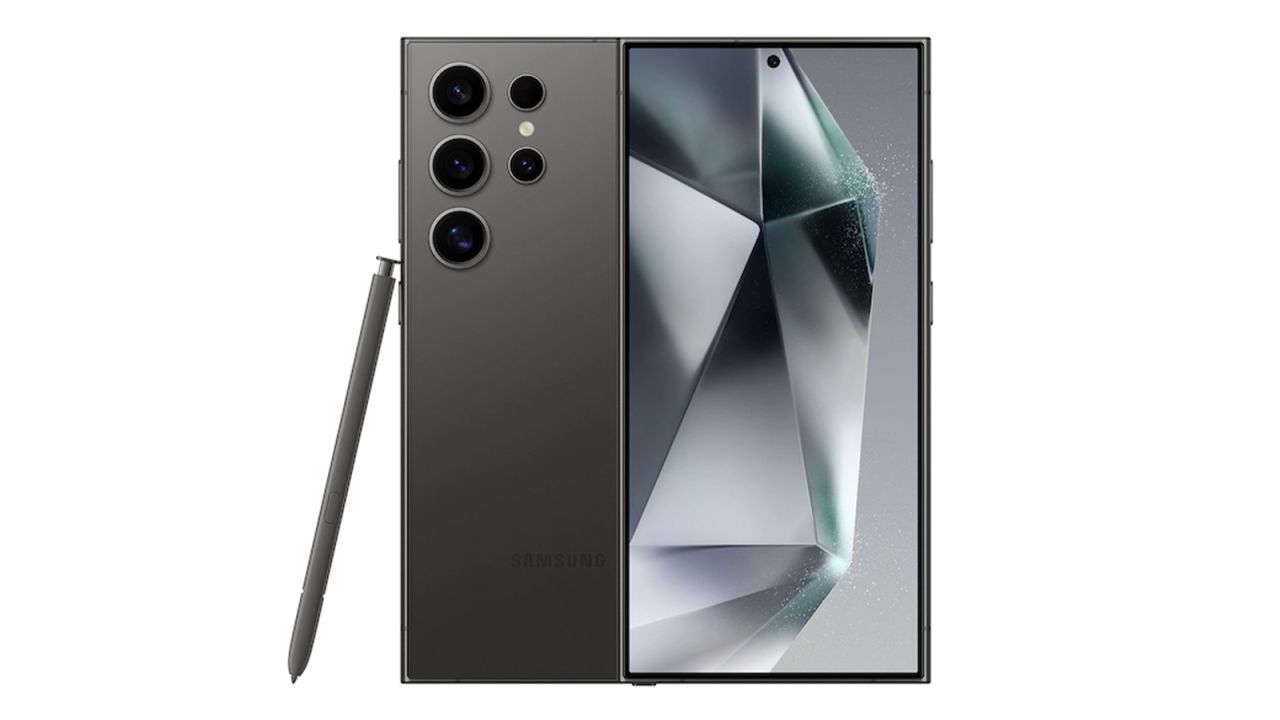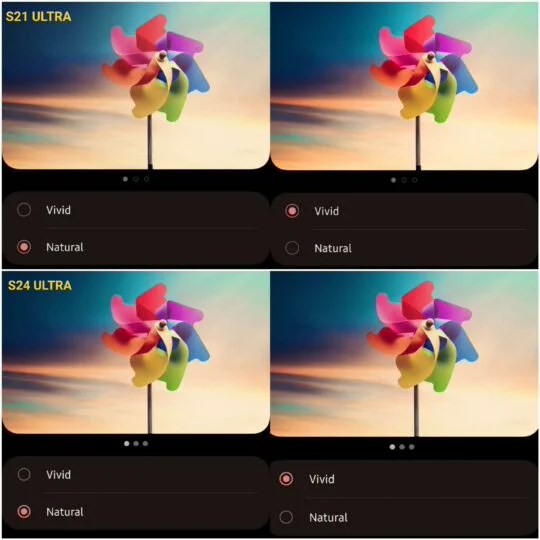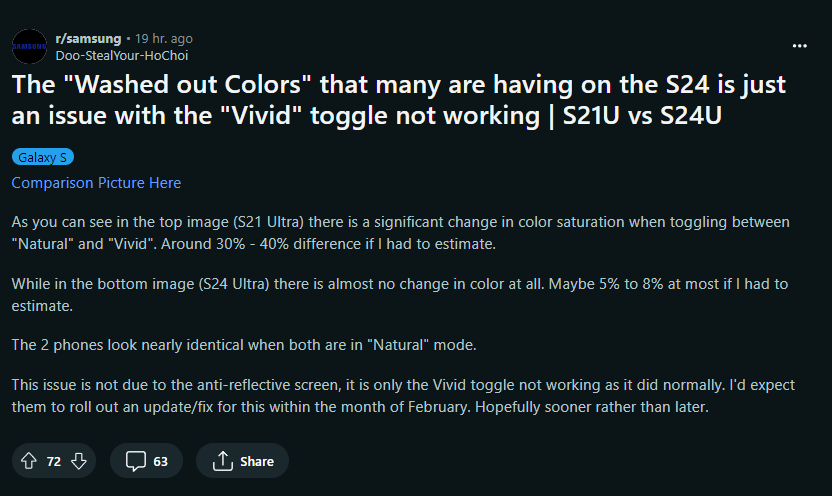 Mobile Tutorial
Mobile Tutorial
 Mobile News
Mobile News
 Users report that the screen color of Samsung Galaxy S24 series mobile phones is light in 'Vivid' mode
Users report that the screen color of Samsung Galaxy S24 series mobile phones is light in 'Vivid' mode
Users report that the screen color of Samsung Galaxy S24 series mobile phones is light in 'Vivid' mode
According to news on January 30, the new Samsung Galaxy S24 series has been officially released recently. Although the new mobile phone screen is brighter, the body is stronger, the performance is stronger, the camera is better, and the battery life is longer, the upgraded Gorilla Victus 2 glass It is also known as one of the most underrated highlights. However, the new phone is not flawless, and there seems to be color issues with the display.
 Some Galaxy S24 Ultra users have reported that their phones display lighter colors in Vivid color mode compared to the Galaxy S23 Ultra. This issue only occurs when using "Vivid" color mode, switching to "Natural" mode, the colors are basically consistent with the S23 Ultra. Additionally, the Galaxy S24 and Galaxy S24 appear to be suffering from the same issue.
Some Galaxy S24 Ultra users have reported that their phones display lighter colors in Vivid color mode compared to the Galaxy S23 Ultra. This issue only occurs when using "Vivid" color mode, switching to "Natural" mode, the colors are basically consistent with the S23 Ultra. Additionally, the Galaxy S24 and Galaxy S24 appear to be suffering from the same issue.  The above picture compares the screen performance of Galaxy S21 Ultra and Galaxy S24 Ultra in "Vivid" mode. It can be seen that the color saturation of the S21 Ultra is significantly improved, while the hue change of the S24 Ultra is not obvious. Some users suspect that the switching function of "Vivid" mode may be faulty and cannot function properly. If it's a software issue, Samsung can easily fix it with a system update. As of press time, Samsung has not responded to this, and it is unclear whether a hardware or software issue caused the problem.
The above picture compares the screen performance of Galaxy S21 Ultra and Galaxy S24 Ultra in "Vivid" mode. It can be seen that the color saturation of the S21 Ultra is significantly improved, while the hue change of the S24 Ultra is not obvious. Some users suspect that the switching function of "Vivid" mode may be faulty and cannot function properly. If it's a software issue, Samsung can easily fix it with a system update. As of press time, Samsung has not responded to this, and it is unclear whether a hardware or software issue caused the problem.  According to Sammobile reports, in addition to screen color issues, the Galaxy S24 Ultra’s always-on display mode also has some shortcomings. Users complained that some options were missing, such as landscape display and separate brightness controls. The Galaxy S24 series’ always-on display mode brightness is tied to the home screen brightness, which may be too bright at night. In addition, mobile phone cameras are prone to overexposure when shooting in daylight, and the detail performance in low-light conditions is not satisfactory.
According to Sammobile reports, in addition to screen color issues, the Galaxy S24 Ultra’s always-on display mode also has some shortcomings. Users complained that some options were missing, such as landscape display and separate brightness controls. The Galaxy S24 series’ always-on display mode brightness is tied to the home screen brightness, which may be too bright at night. In addition, mobile phone cameras are prone to overexposure when shooting in daylight, and the detail performance in low-light conditions is not satisfactory. The above is the detailed content of Users report that the screen color of Samsung Galaxy S24 series mobile phones is light in 'Vivid' mode. For more information, please follow other related articles on the PHP Chinese website!

Hot AI Tools

Undresser.AI Undress
AI-powered app for creating realistic nude photos

AI Clothes Remover
Online AI tool for removing clothes from photos.

Undress AI Tool
Undress images for free

Clothoff.io
AI clothes remover

AI Hentai Generator
Generate AI Hentai for free.

Hot Article

Hot Tools

Notepad++7.3.1
Easy-to-use and free code editor

SublimeText3 Chinese version
Chinese version, very easy to use

Zend Studio 13.0.1
Powerful PHP integrated development environment

Dreamweaver CS6
Visual web development tools

SublimeText3 Mac version
God-level code editing software (SublimeText3)

Hot Topics
 1378
1378
 52
52
 Samsung Galaxy S24 series mobile phone screens have problems again, users complained about 'graininess' and 'horizontal stripes'
Feb 13, 2024 pm 06:30 PM
Samsung Galaxy S24 series mobile phone screens have problems again, users complained about 'graininess' and 'horizontal stripes'
Feb 13, 2024 pm 06:30 PM
According to news on February 13, Samsung’s latest Galaxy S24 series smartphones have screen problems, and many users have noticed some strange flaws. According to AndroidPolice, multiple Reddit users reported that the Galaxy S24 screen has a strange "grainy" problem. In one post, the user asked others if they noticed graininess on the S24 display while viewing apps or other content with dark backgrounds. Users who participated in the poll said they noticed this issue on the S24Plus, S24 and S24Ultra. One user said that they also encountered this problem when trying out the S24 series display machine in the store. Another user said: "I did see the screen
 Domestic mobile phones lead the dimming frequency, Samsung Galaxy S24 series mobile phone PWM frequency modulation is upgraded to 492Hz
Jan 25, 2024 am 09:03 AM
Domestic mobile phones lead the dimming frequency, Samsung Galaxy S24 series mobile phone PWM frequency modulation is upgraded to 492Hz
Jan 25, 2024 am 09:03 AM
According to news on January 24, the Galaxy S24 mobile phone series launched by Samsung this year should be more eye-friendly. The reason is that they have finally upgraded the PWM (pulse width modulation) dimming refresh rate of the AMOLED display, surpassing the 480Hz of the iPhone and reaching 492Hz, which can reduce screen flicker and relieve eye fatigue. Simply put, PWM is a technology used to control screen brightness. Traditional LCD screens adjust brightness by changing the intensity of the backlight, while OLED screens do this by rapidly switching pixels on and off, often referred to as "flickering." It is understood that in 2017, iPhoneX used an OLED screen for the first time, and some users found that they felt uncomfortable or even had headaches when using the phone. One reason is that when
 Samsung Galaxy S24 series releases One UI 6.1, adding support for wallpapers and widgets with screen-free display function
Jan 18, 2024 am 09:21 AM
Samsung Galaxy S24 series releases One UI 6.1, adding support for wallpapers and widgets with screen-free display function
Jan 18, 2024 am 09:21 AM
According to news on January 18, Samsung’s latest flagship mobile phones Galaxy S24, Galaxy S24+ and Galaxy S24 Ultra are the first to be equipped with the OneUI6.1 system, which brings many innovative features driven by AI and new processors, and is equipped with brighter, more sensitive and more power-saving features. screen. Among them, the upgrade of the adaptive display function (AoD) is particularly eye-catching, and the playability has been greatly improved. Note that the Galaxy S24 series’ screen display is no longer limited to displaying clocks and notification icons, and now supports wallpapers and widgets for the first time. This means that when you lock the screen, the phone wallpaper will automatically dim and continue to display information from widgets, such as the usual clock, music player and notification icons. When turning on/off the screen, the wall
 The price of the Chinese version of the Samsung Galaxy S24 series mobile phones has been announced, starting at 5,999 yuan
Jan 18, 2024 am 08:24 AM
The price of the Chinese version of the Samsung Galaxy S24 series mobile phones has been announced, starting at 5,999 yuan
Jan 18, 2024 am 08:24 AM
According to news on January 18, Samsung officially released the Galaxy S24 series of mobile phones today. The price of the first-mover phone in China has been announced, starting from 5,999 yuan, and will be delivered starting from January 26. The specific prices are as follows: Galaxy S248+256GB: 5999 yuan 12+256GB: 6499 yuan 8+512GB: 6999 yuan Galaxy S24+12+256GB: 7499 yuan 12+512GB: 8499 yuan Galaxy S24 Ultra12+256GB: 10199 yuan 12+512GB: 11199 yuan 12 +1TGB: 13,199 Yuan Samsung Forerunner’s 8 major purchasing privileges are as follows, including priority delivery (delivery will begin on January 26)
 Troubled by green lines on the screen, Samsung India offers free screen replacement for Galaxy S21 / S22 mobile phone users
Apr 22, 2024 am 08:10 AM
Troubled by green lines on the screen, Samsung India offers free screen replacement for Galaxy S21 / S22 mobile phone users
Apr 22, 2024 am 08:10 AM
According to reports on April 21, according to the Sammobile website, since last year, users have continued to report that some Samsung mobile phones will have screen green lines. For this reason, Samsung India has decided to provide free screen replacement for Galaxy S21/S22 mobile phone users. Samsung India has been offering free display replacement for affected devices since July last year. Eligible devices include the Galaxy S20 series and Galaxy Note20 series. The company has now expanded this list to include the Galaxy S21 series and Galaxy S22 series. Users must make an appointment at a Samsung service center before April 30, 2024, to get a free replacement from the company. It was previously reported that the problem manifested itself as a
 Users report that the screen color of Samsung Galaxy S24 series mobile phones is light in 'Vivid' mode
Jan 30, 2024 pm 11:30 PM
Users report that the screen color of Samsung Galaxy S24 series mobile phones is light in 'Vivid' mode
Jan 30, 2024 pm 11:30 PM
According to news on January 30, the new Samsung Galaxy S24 series has been officially released recently. Although the new mobile phone screen is brighter, the body is stronger, the performance is stronger, the camera is better, and the battery life is longer, the upgraded Gorilla Victus2 glass is even more Hailed as one of the most underrated highlights. However, the new phone is not flawless, and there seems to be color issues with the display. Some Galaxy S24 Ultra users have reported that their phones display lighter colors in "vivid" color mode compared to Galaxy S23 Ultra. This problem only occurs when using the "Vivid" color mode. After switching to "Natural" mode, the color is basically the same as that of the S23 Ultra. In addition, GalaxyS24 and Galaxy
 There is a problem with the 'Game Optimization Service' of Samsung Galaxy S24 series mobile phones: After disabling it, it only increases power consumption and the frame rate does not increase.
Feb 21, 2024 pm 02:00 PM
There is a problem with the 'Game Optimization Service' of Samsung Galaxy S24 series mobile phones: After disabling it, it only increases power consumption and the frame rate does not increase.
Feb 21, 2024 pm 02:00 PM
According to news on February 21, Samsung’s “Game Optimization Service” (GOS) controversy seems to have appeared again in the new Galaxy S24 series, at least in the popular game “Original God”. GOS is designed to control phone temperature by reducing CPU and GPU frequency, but this also results in performance degradation. In 2022, GOS caused controversy when it was found to be throttling performance only in games and not in benchmark applications. Samsung then gave users the option to choose fewer performance limits with an "Experimental Game Performance Management" option. Enabling this option reduces the amount of CPU and GPU underclocking during gaming, thereby increasing the frame rate, but will still underclock when the phone is too hot. It has been noted that completely disabling GOS requires using developer commands via PC, which is not feasible for ordinary users.
 Released on July 10, Samsung Galaxy Z Fold 6 / Z Flip 6 foldable mobile phone official protective case exposed
Jun 27, 2024 am 11:17 AM
Released on July 10, Samsung Galaxy Z Fold 6 / Z Flip 6 foldable mobile phone official protective case exposed
Jun 27, 2024 am 11:17 AM
According to news on June 27, Samsung has officially confirmed that it will hold a Galaxy Unpacked new product launch conference in Paris on July 10. The highly anticipated foldable mobile phones Galaxy Z Fold 6 and Z Flip 6 are expected to be unveiled at this event. There have been a lot of leaks about Samsung's next-generation foldable phones before, and now X user @MysteryLupin has shared spy photos of the two phones with official protective cases. Note that the spy photos show the keychain protective case of Galaxy Z Flip 6, which is available in three colors: dark blue, gray and green. It is worth noting that compared with the previous generation product, the camera module of ZFlip6 is more protruding and consistent with the color of the back of the fuselage.



